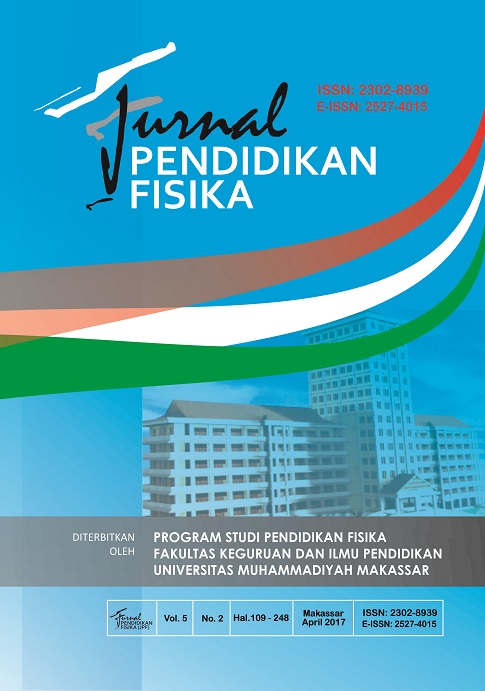Pengembangan Media Tutorial Pembelajaran IPA Berbasis Web Untuk Peserta Didik Kelas VIII SMPN 5 Pallangga
DOI:
https://doi.org/10.26618/jpf.v5i2.621Abstract
Telah dilakukan penelitian & pengembangan yang bertujuan untuk melihat profil media tutorial berbasis web. Prosedur penelitian menggunakan model yang diadopsi four-D (4-D) yang terdiri dari : tahap pendefinisian mencakup analisis awal, analisis perserta didik, analisis konsep, dan analisis tugas. Tahap perancangan mencakup pemilihan media, pemilihan format, dan rancangan awal. Tahap pengembangan, dilakukan validasi oleh para ahli dan direvisi sehingga didapatkan hasil yang layak untuk digunakan. Hasil penelitian menunjukkan bahwa media tutorial berbasis web dinyatakan valid oleh dua orang pakar dan persepsi praktisi/guru terhadap media tutorial berbasis web adalah 80,65% berarti diterima positif sehingga layak digunakan dalam pembelajaran, begitu pula respon peserta didik adalah 80,47% berarti diterima dengan positif.
Kata kunci: Media tutorial berbasis web
Research and Development had been conducted which aimed at discovering the profile of web-base tutorial media. The procedure of the research employed four-D (4-D) model, which consisted of defining phase included preliminary analysis, student analysis, concept analysis, and task analysis; designing phase that the valudation was conducted by the experts and revision was done to obtain feasible result to be used. The result of the study reveal that the web-based tutorial media is confirmed as valid by two experts and the practitioners/teachers’ perception on the web-based tutorial media developed is feasible as well as the students’ perception on web-based media is on very good category.
Keywords: web-based tutorial media
References
Munir, 2008. Kurikulum Berbasis Teknologi Informasi dan Komunikasi. Bandung: Alfabeta.
Rosenberg, M. J. 2001. E-Learning: Strategies for Delivering Knowledge in the Digital Age. New York: McGraw-Hill.
Thohari. 1978. Program Pengajaran Ilmu Pengetahuan Alam.Yogyakarta
Suyoso, Suharto dan Sujoko. 1998. Ilmu Alamiah Dasar. Yogyakarta: IKIP
Handiyanto, Koes. 2003. Strategi pembelajaran Fisika. Malang: Universitas NegeriMalang.
Sudjana, Nana dan Ahmad Rivai. 2002. Media Pengajaran. Bandung: Sinar BaruAlgesindo.
Arsyad, Azhar. 2008. Media Pembelajaran. Jakarta: PT RajaGrafindo Persada.
Rusman.2010. Model – Model Pembelajaran. Jakarta : PT Raja Grafindo Persada.
Majid,Abdul.2005.Perencanaan Pembelajaran (mengembangkan kompetensi guru).Bandung: Remaja Rosdakarya
Oos M, Anwas. 2003.Model Inovasi E-Learning Dalam Meningkatkan Mutu Pendidikan.Jurnal TEKNODIK. Edisi No.12/VII/Oktober/2003
Herman. 1999.Pemanfaatan Internet Untuk Memperbaharui Model Pengajaran di Perguruan Tinggi.Jurnal Cakrawala Pendidikan.No.4 (XVII): 162-166
Davidson & K.LRasmussen, G.V.2006. Web based learning: designing, implementation, and evaluation. Upper Saddle River, NJ: PearsonEducation, Inc.
Thiagarajan, Sivasailam Dorothy S. S. & Melvin I. S. 1974. Instructional Development for Training Teachers of Exceptional Children. Indiana: Indiana University
Downloads
Published
Issue
Section
License
Copyright:
Authors who publish with this journal agree to the following terms:
1. Authors retain copyright and grant the journal right of first publication with the work simultaneously licensed under a Creative Commons Attribution-ShareAlike 4.0 International License that allows others to share the work with an acknowledgement of the work's authorship and initial publication in this journal.
2. Authors are able to enter into separate, additional contractual arrangements for the non-exclusive distribution of the journal's published version of the work (e.g., post it to an institutional repository or publish it in a book), with an acknowledgement of its initial publication in this journal.
3. Authors are permitted and encouraged to post their work online (e.g., in institutional repositories or on their website) prior to and during the submission process, as it can lead to productive exchanges, as well as earlier and greater citation of published work.
Licence:
Authors are free to:
1. Share: Copy and redistribute the material in any medium or format
2. Adapt: Remix, transform, and build upon the material for any purpose, even commercially.
The licensor cannot revoke these freedoms as long as the authors follow the license terms, which include the following:
1. Attribution: You must give appropriate credit, provide a link to the license, and indicate if changes were made. You may do so in any reasonable manner, but not in any way that suggests the licensor endorses you or your use.
2. ShareAlike: If you remix, transform, or build upon the material, you must distribute your contributions under the same license as the original.
3. No additional restrictions: You may not apply legal terms or technological measures that legally restrict others from doing anything the license permits.
Jurnal Pendidikan Fisika is licensed under a Creative Commons Attribution-ShareAlike 4.0 International License.

